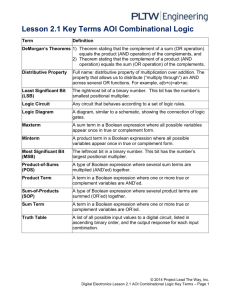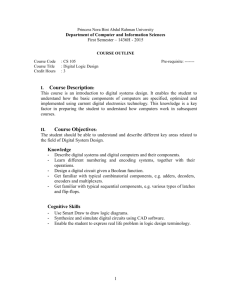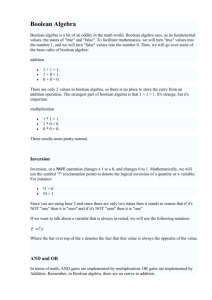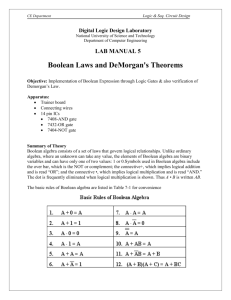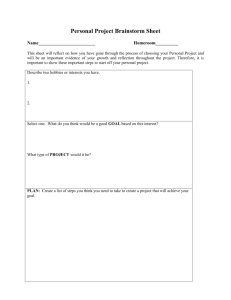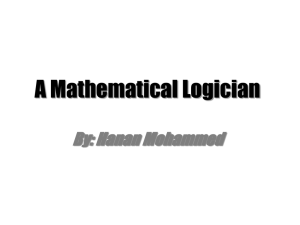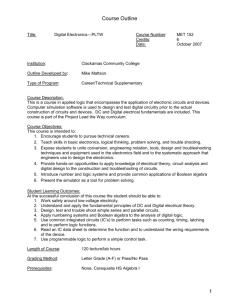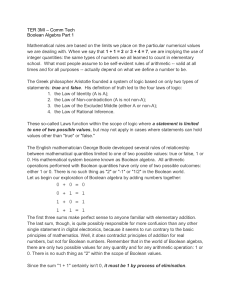File
advertisement
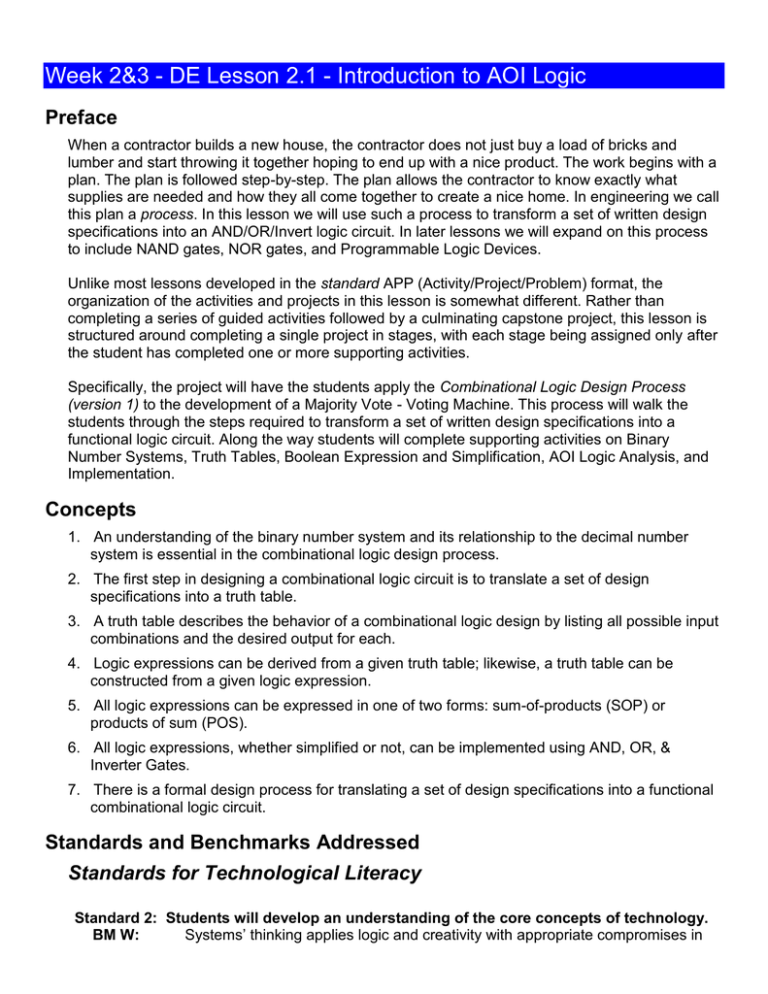
Week 2&3 - DE Lesson 2.1 - Introduction to AOI Logic Preface When a contractor builds a new house, the contractor does not just buy a load of bricks and lumber and start throwing it together hoping to end up with a nice product. The work begins with a plan. The plan is followed step-by-step. The plan allows the contractor to know exactly what supplies are needed and how they all come together to create a nice home. In engineering we call this plan a process. In this lesson we will use such a process to transform a set of written design specifications into an AND/OR/Invert logic circuit. In later lessons we will expand on this process to include NAND gates, NOR gates, and Programmable Logic Devices. Unlike most lessons developed in the standard APP (Activity/Project/Problem) format, the organization of the activities and projects in this lesson is somewhat different. Rather than completing a series of guided activities followed by a culminating capstone project, this lesson is structured around completing a single project in stages, with each stage being assigned only after the student has completed one or more supporting activities. Specifically, the project will have the students apply the Combinational Logic Design Process (version 1) to the development of a Majority Vote - Voting Machine. This process will walk the students through the steps required to transform a set of written design specifications into a functional logic circuit. Along the way students will complete supporting activities on Binary Number Systems, Truth Tables, Boolean Expression and Simplification, AOI Logic Analysis, and Implementation. Concepts 1. An understanding of the binary number system and its relationship to the decimal number system is essential in the combinational logic design process. 2. The first step in designing a combinational logic circuit is to translate a set of design specifications into a truth table. 3. A truth table describes the behavior of a combinational logic design by listing all possible input combinations and the desired output for each. 4. Logic expressions can be derived from a given truth table; likewise, a truth table can be constructed from a given logic expression. 5. All logic expressions can be expressed in one of two forms: sum-of-products (SOP) or products of sum (POS). 6. All logic expressions, whether simplified or not, can be implemented using AND, OR, & Inverter Gates. 7. There is a formal design process for translating a set of design specifications into a functional combinational logic circuit. Standards and Benchmarks Addressed Standards for Technological Literacy Standard 2: Students will develop an understanding of the core concepts of technology. BM W: Systems’ thinking applies logic and creativity with appropriate compromises in complex real-life problems. BM Y: The stability of a technological system is influenced by all of the components in the system especially those in the feedback loop. BM Z: Selecting resources involves trade-offs between competing values, such as availability, cost, desirability, and waste. BM AA: Requirements involve the identification of the criteria and constraints of a product or system and the determination of how they affect the final design and development. BM BB: Optimization is an on going process or methodology of designing or making a product and is dependent on criteria and constraints. BM FF: Complex systems have many layers of controls and feedback loops to provide information. Standard 9: Students will develop an understanding of engineering design. BM I: Established design principles are used to evaluate existing designs, to collect data, and to guide the design process. BM J: Engineering design is influenced by personal characteristics, such as creativity, resourcefulness, and the ability to visualize and think abstractly. BM K: A prototype is a working model used to test a design concept by making actual observations and necessary adjustments. BM L: The process of engineering design takes into account a number of factors. Standard 10: Students will develop an understanding of the role of troubleshooting, research and development, invention and innovation, and experimentation in problem solving. BM I: Research and development is a specific problem-solving approach that is used intensively in business and industry to prepare devices and systems for the marketplace. BM J: Technological problems must be researched before they can be solved. BM K: Not all problems are technological, and not every problem can be solved using technology. BM L: Many technological problems require a multidisciplinary approach. Standard 11: Students will develop abilities to apply the design process. BM N: Identify criteria and constraints and determine how these will affect the design process. BM O: Refine a design by using prototypes and modeling to ensure quality, efficiency, and productivity of the final product. BM P: Evaluate the design solution using conceptual, physical, and mathematical models at various intervals of the design process in order to check for proper design and to note areas where improvements are needed. BM Q: Develop and produce a product or system using a design process. BM R: Evaluate final solutions and communicate observation, processes, and results of the entire design process, using verbal, graphic, quantitative, virtual, and written means, in addition to three-dimensional models. Standard 12: Students will develop the abilities to use and maintain technological products and systems. BM L: Document processes and procedures and communicate them to different audiences using appropriate oral and written techniques. BM M: Diagnose a system that is malfunctioning and use tools, materials, machines, and knowledge to repair it. BM N: Troubleshoot, analyze, and maintain systems to ensure safe and proper function and precision. BM O: Operate systems so that they function in the way they were designed. BM P: Use computers and calculators to access, retrieve, organize and process, maintain, interpret, and evaluate data and information in order to communicate. Standard 13: Students will develop the abilities to assess the impacts of products and systems. BM J: Collect information and evaluate its quality. Standard 17: Students will develop an understanding of and be able to select and use information and communication technologies. BM L: Information and communication technologies include the inputs, processes, and outputs associated with sending and receiving information. BM M: Information and communication systems allow information to be transferred from human to human, human to machine, machine to human, and machine to machine. BM N: Information and communication systems can be used to inform, persuade, entertain, control, manage, and educate. BM O: Communication systems are made up of source, encoder, transmitter, receiver, decoder, storage, retrieval, and destination. BM P: There are many ways to communicate information, such as graphic and electronic means. BM Q: Technological knowledge and processes are communicated using symbols, measurement, conventions, icons, graphic images, and languages that incorporate a variety of visual, auditory, and tactile stimuli. National Science Education Standards Standard K-12: Unifying Concepts and Processes: As a result of activities in grades K-12, all students should develop understanding and abilities aligned with the following concepts and processes; Systems, order, and organization Evidence, models, and explanation Change, constancy, and measurement Form and function Content Standard A: Science As Inquiry: As a result of activities in grades 9-12, all students should develop; Abilities necessary to do scientific inquiry Understandings about scientific inquiry Standard E: Science and Technology: As a result of activities in grades 9-12, all students should develop Abilities of technological design Understandings about science and technology Principles and Standards for School Mathematics Number and Operations: Algebra: Instructional programs from pre-kindergarten through grade 12 should enable all students to; understand numbers, ways of representing numbers, relationships among numbers, and number systems; understand meanings of operations and how they relate to one another; compute fluently and make reasonable estimates. Instructional programs from pre-kindergarten through grade 12 should enable all students to; understand patterns, relations, and functions; represent and analyze mathematical situations and structures using algebraic symbols; use mathematical models to represent and understand quantitative relationships; analyze change in various contexts. Problem Solving: Reasoning and Proof: Communication: Connections: Representation: Instructional programs from pre-kindergarten through grade 12 should enable all students to; build new mathematical knowledge through problem solving; solve problems that arise in mathematics and in other contexts; apply and adapt a variety of appropriate strategies to solve problems; monitor and reflect on the process of mathematical problem solving. Instructional programs from pre-kindergarten through grade 12 should enable all students to; recognize reasoning and proof as fundamental aspects of mathematics; make and investigate mathematical conjectures; develop and evaluate mathematical arguments and proofs; select and use various types of reasoning and methods of proof. Instructional programs from pre-kindergarten through grade 12 should enable all students to; organize and consolidate their mathematical thinking through communication; communicate their mathematical thinking coherently and clearly to peers, teachers, and others; analyze and evaluate the mathematical thinking and strategies of others; use the language of mathematics to express mathematical ideas precisely. Instructional programs from pre-kindergarten through grade 12 should enable all students to; recognize and use connections among mathematical ideas; understand how mathematical ideas interconnect and build on one another to produce a coherent whole; recognize and apply mathematics in contexts outside of mathematics. Instructional programs from pre-kindergarten through grade 12 should enable all students to; create and use representations to organize, record, and communicate mathematical ideas; select, apply, and translate among mathematical representations to solve problems; use representations to model and interpret physical, social, and mathematical phenomena. Standards for English Language Arts Standard 1: Standard 4: Standard 12: Students read a wide range of print and non-print texts to build an understanding of texts of themselves, and of the cultures of the United States and the world; to acquire new information; to respond to the needs and demands of society and the workplace; and for personal fulfillment. Among these texts are fiction and nonfiction, classical and contemporary works. Students adjust their use of spoken, written, and visual language (e.g. conventions, style, vocabulary) to communicate effectively with a variety of audiences and for different purposes. Students use spoken, written and visual language to accomplish their own purposes (e.g. for learning, enjoyment, persuasion, and the exchange of information). Performance Objectives It is expected that students will: Convert numbers between the binary and decimal number systems. Translate design specifications into truth tables. Extract un-simplified logic expressions from truth tables. Construct truth tables from logic expressions. Use the rules and laws of Boolean algebra, including DeMorgan’s, to simplify logic expressions. Analyze AOI (AND/OR/Invert) combinational logic circuits to determine their equivalent logic expressions and truth tables. Design combinational logic circuits using AOI logic gates. Translate a set of design specifications into a functional AOI combinational logic circuit following a formal design process. Use Circuit Design Software (CDS) and a Digital Logic Board (DLB) to simulate and prototype AOI logic circuits. Assessment Explanation How will the knowledge about AOI Logic aid you in designing, building, and testing of a circuit? Interpretation Students will define and explain the difference between a AND gate, OR gate, and an inverter gate. Self-knowledge Explain to a fifth grader the difference between a binary and decimal number system. Essential Questions 1. What are the processes for converting numbers between the binary and decimal number systems, and why is the understanding of these two numbers systems essential to your ability to design combinational logic circuits? 2. What is the relationship between a combinational logic design’s truth table, logic expression, and circuit implementation? Describe the process of obtaining any of the first two given the third. 3. When you simplify a logic expression using Boolean algebra, how do you know that you have the simplest solution and that the solution is correct? 4. In terms of circuit implementation, what is the advantage of representing all logic expression in either the SOP or POS form? 5. Defend the following statement: “All logic expression, regardless of complexity, can be implemented with AND, OR, & Inverter Gates.” 6. What are the steps in the design process of converting a set of design specifications into a functional combinational logic circuit? Key Terms Associative Property A mathematical function is associative if its operands can be grouped in any order without affecting the result. For example, addition is associative ((a+b) + c = a + (b+c)), but subtraction is not ((a-b) –c ≠ a-(b-c)). Binary Number System A number system used extensively in digital systems, based on the number 2. It uses two digits to write any number. Boolean Algebra Algebraic process used as a tool in the design and analysis of digital systems. In Boolean algebra only two values are possible, 0 and 1. Boolean Expression An algebraic expression made up of Boolean variables and operators, such as AND (), OR (+), or NOT (-). Also referred to as Boolean function or a logic function. Boolean Theorems Rules that can be applied to Boolean algebra to simplify logic expressions. Boolean Variable A variable having only two possible values, such as HIGH/LOW, 1/0, On/Off, or True/False. Combinational Logic Digital circuitry in which an output is derived from the combination of inputs, independent of the order in which they are applied. Commutative Property A mathematical operation is commutative if it can be applied to its operands in any order without affecting the result. For example, addition is commutative (a+b=b+a), but subtraction is not (a-b≠b-a). Decimal System Number system that uses 10 different digits or symbols to represent a quantity. DeMorgan’s Theorems 1) Theorem stating that the complement of a sum (OR operation) equals the product (AND operation) of the complements, and 2) theorem stating that the complement of a product (AND operation) equals the sum (OR operation) of the complements. Distributive Property Full name: distributive property of multiplication over addition. The property that allows us to distribute (“multiply through”) an AND across several OR functions. For example, a(b+c)=ab+ac. Least Significant Bit (LSB) The rightmost bit of a binary num ber. This bit has the number’s smallest positional multiplier. Logic Circuit Any circuit that behaves according to a set of logic rules. Logic Diagram A diagram, similar to a schematic, showing the connection of logic gates. Maxterm A sum term in a Boolean expression where all possible variables appear once in true or complement form. Minterm A product term in a Boolean expression where all possible variables appear once in true or complement form. Most Significant Bit (MSB) The leftmost bit in a binary number. This bit has the number’s loargest positional multiplier. Product-of-Sums (POS) A type of Boolean expression where several sum terms are multiplied (ANDed) together. Product Term A term in a Boolean expression where one or more true or complement variables are ANDed. Sum-of-Products (SOP) A type of Boolean expression where several product terms are summed (ORed) together. Sum Term A term in a Boolean expression where one or more true or complement variables are ORed. Truth Table A list of all possible input values to a digital circuit, listed in ascending binary order, and the output response for each input combination. Day-by-Day Plans Time: 10 days Day 1: The teacher will present Introduction to Logic & Datasheets.ppt Students will take notes in their engineering journals. The teacher will distribute and introduce Activity 1.3.4 Introduction to Logic & Datasheets. Students will work on Activity 1.3.4 Introduction to Logic & Datasheets. The teacher will present Troubleshooting.ppt Students will take notes in their engineering journals. The teacher will present Binary Number System & Conversion.ppt. Students will take notes in their engineering notebooks/portfolios. The teacher will distribute and introduce Activity 2.1.2 Binary Numbers & Conversion. Students will work on Activity 2.1.2 Binary Numbers & Conversion. Day 2: The teacher will present Truth Tables & Logic Expressions.ppt. Students will take notes in their engineering notebooks/portfolios. The teacher will distribute and introduce Activity 2.1.3 Truth Tables & Logic Expressions. Students will work on Activity 2.1.3 Truth Table & Logic Expressions. The teacher will review the Word Problem - Create Truth Table - Write Boolean Expression steps of the Combinational Logic Design Process (v1) flow chart (see day 1). Students will complete procedure steps 1 and 2 for the Majority Vote Project, documenting their work in their engineering notebooks/portfolios. The teacher will assist the students as needed. Using the Project 2.1.1 Majority Vote – Voting Machine Answer Key as a guide, the teacher will review the results with the class to ensure that each student understands the process and has obtained the correct results. Day 3-4: The teacher will present AOI Logic Analysis.ppt. Students will take notes in their engineering notebooks/portfolios. The teacher will distribute and introduce Activity 2.1.4 AOI Logic Analysis. Students will work on Activity 2.1.4 AOI Logic Analysis. The teacher will assess student work using Activity 2.1.4 AOI Logic Analysis Answer Key. The teacher will present AOI Logic Implementation.ppt. Students will take notes in their engineering notebooks/portfolios. The teacher will distribute and introduce Activity 2.1.5 AOI Logic Implementation. Students will work on Activity 2.1.5 AOI Logic Analysis. Day 5: The teacher will review the Write Logic Expression – No Simplification – AOI Logic Implementation steps of the Combinational Logic Design Process (v1) flow chart (see day 1). Students will complete procedure steps 3 and 4 for the Majority Vote Project, documenting their work in their engineering notebooks/portfolios. The teacher will assist the students as needed. Using the Project 2.1.1 Majority Vote – Voting Machine Answer Key as a guide, the teacher will review the results with the class to ensure that each student understands the process and has obtained the correct results. Day 6&7: The teacher will present Boolean Algebra.ppt. Students will take notes in their engineering notebooks/portfolios. The teacher will distribute and introduce Activity 2.1.6 Boolean Algebra and Activity 2.1.6a Boolean Algebra and DeMorgan’s Theorems Students will work on Activity 2.1.6 Boolean Algebra. After the class has completed the first few problems in the activity, the teacher will review these problems with the class to clarify any misconceptions. The students will have the remainder of the class to complete the activity. Any unfinished work will be completed as homework. The teacher will present DeMorgan’s Theorems.ppt. Students will take notes in their engineering notebooks/portfolios. The teacher will distribute and introduce Activity 2.1.7 DeMorgan’s Theorems. Students will work on Activity 2.1.7 DeMorgan’s Theorems. Day 8: The teacher will review the Write Logic Expression – Boolean Simplification – AOI Logic Implementation steps of the Combinational Logic Design Process (v1) flow chart (see day 1). Students will complete procedure step 5 for the Majority Vote Project, documenting their work in their engineering notebooks/portfolios. The teacher will assist the students as needed. Day 9: The teacher will review the Write Logic Expression – Boolean Simplification – AOI Logic Implementation steps of the Combinational Logic Design Process (v1) flow chart (see day 1). Students will complete procedure steps 6, 7, and 8 for the Majority Vote Project, documenting their work in their engineering notebooks/portfolios. The teacher will assist the students as needed. Using the Project 2.1.1 Majority Vote – Voting Machine Answer Key as a guide, the teacher will review the results with the class to ensure that each student understands the process and has obtained the correct results. Instructional Resources Presentations Introduction to Logic & Datasheets Troubleshooting Combo Logic Design Process Binary Number Systems & Conversion Truth Tables & Logic Expressions AOI Logic Analysis AOI Logic Implementation Boolean Algebra DeMorgan’s Theorems Word Documents Activity 1.3.4 Introduction to Logic & Datasheets Project 2.1.1 Majority Vote Activity 2.1.2 Binary Numbers & Conversion Activity 2.1.3 Truth Tables & Logic Expressions Activity 2.1.4 AOI Logic Analysis Activity 2.1.5 AOI Logic Implementation Activity 2.1.6 Boolean Algebra Activity 2.1.6a Boolean Algebra and DeMorgan’s Theorems Activity 2.1.7 DeMorgan’s Theorems
